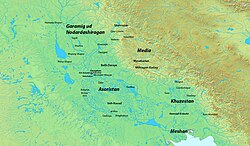Sassanid Asuristan
| Asōristān | |||||
| of the Sasanian Empire | |||||
|
|||||
| Map of Asoristan and its surrounding provinces | |||||
| Capital | Ctesiphon | ||||
| Historical era | Late Antiquity | ||||
| • | Sassanian conquest | 226 | |||
| • | First Muslim campaign | 633 | |||
| • | Second Muslim campaign | 637 | |||
| Today part of |
|
||||
Asōristān (Middle Persian: Asōrestān, Āsūrestān) was the name of the Sasanian provinces of Mesopotamia from 226 to 637.
During the Achaemenid (550–330 BCE) and Parthian Empires (150 BCE – 225 CE), this region had been known by the Old Persian name Athura. Asōristān, Middle Persian "land of Assyria", was the capital province of the Sasanian Empire and was called Dil-ī Ērānshahr, meaning "Heart of Iran". The city of Ctesiphon served as the capital of both the Parthian and Sasanian Empires, and was for some time the largest city in the world. The main language spoken by the Assyrian people was Eastern Aramaic, with the local Syriac language becoming an important vehicle for Syriac Christianity. The Church of the East was founded in Asōristān. Asōristān was largely identical with ancient Mesopotamia. The northern border is somewhat uncertain but probably went along a line from Anta to Takrīt. Ḥīra was probably the southernmost point, the border then following the northern part of the swamps of Wasit.
The Parthians had exercised only loose control at times, allowing for a number of Syriac-speaking Assyrian kingdoms to flourish in Upper Mesopotamia, the independent Osroene, as well as the districts of Adiabene and the partly Assyrian state of Hatra. The Sasanian Empire conquered Assyria and Mesopotamia from the Parthians during the 220s, and by 260 had abolished these city-states, with the 3000-year-old city of Assur being sacked in 256. Some regions appear to have remained partly autonomous as late as the latter part of the fourth century, with an Assyrian king named Sinharib reputedly ruling a part of Assyria in the 370s.
...
Wikipedia

